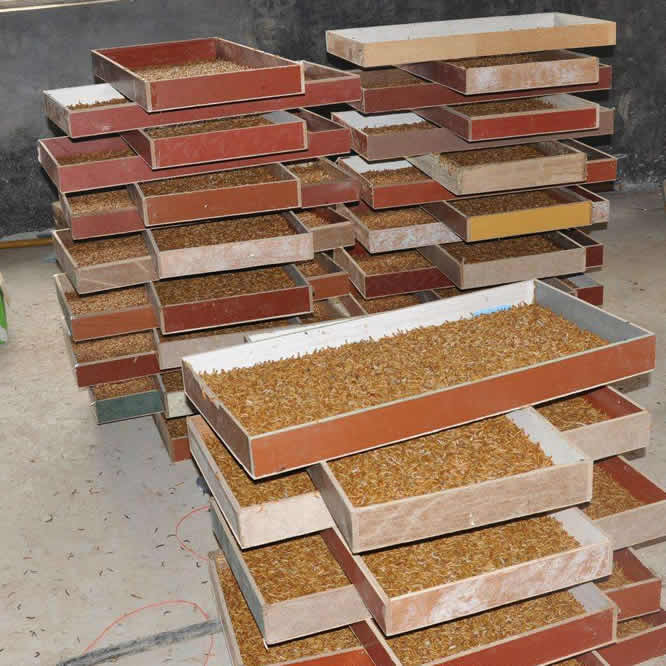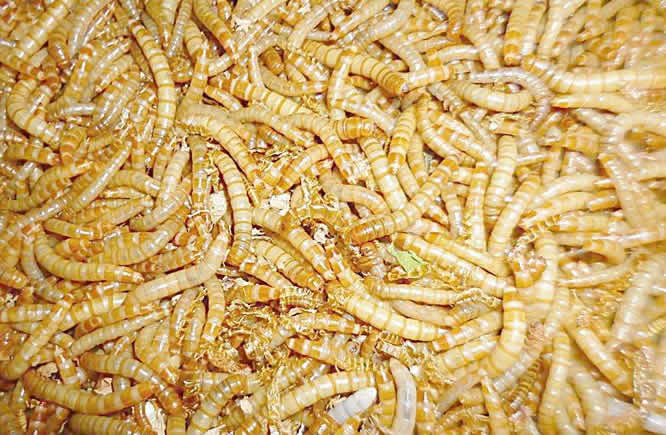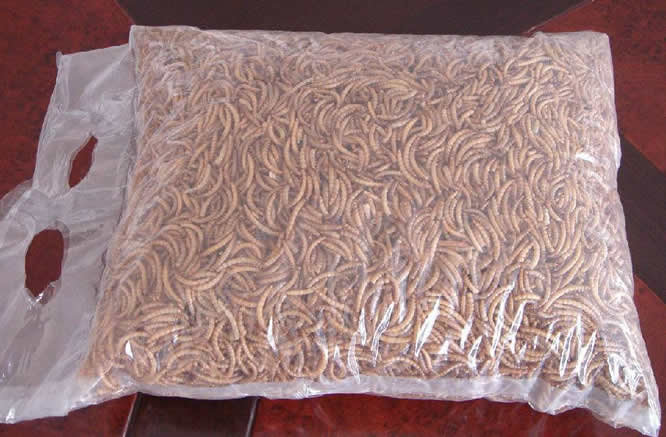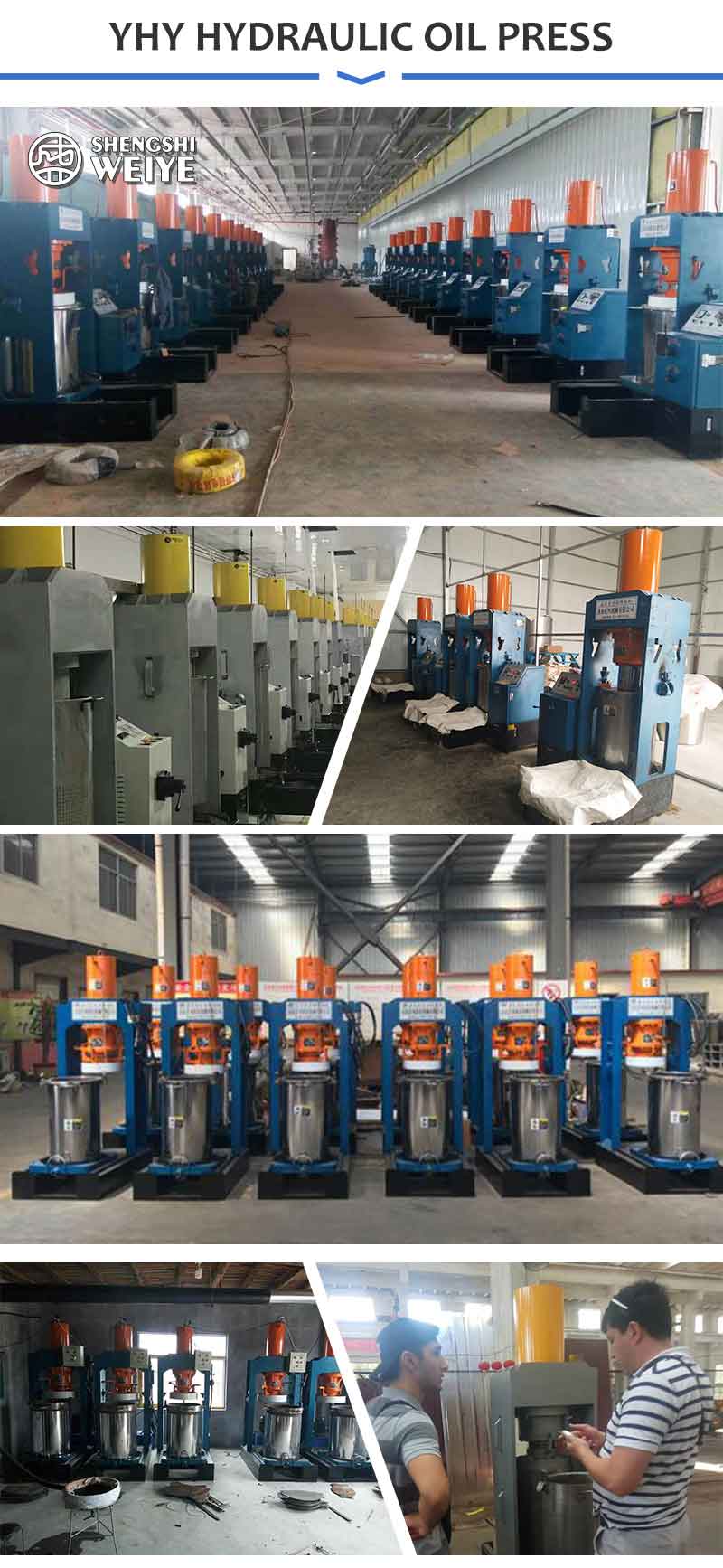High oil yield pressers the flour beetle Oil extraction equipment According to the analysis, Tenebrio molitor contains 50% protein in its young, 57% in its pupa and 6 "in its adult. In addition, it also contains major elements such as phosphorus, potassium, iron, sodium and aluminum, as well as a variety of trace elements and 16 kinds of amino acids necessary for animal growth. For every 100g dry product, it contains up to 847.91 mg of amino acids. Its business and cultivation share ranks first in all kinds of feeds. It is used by famous zoos at home and abroad as a breeding rare bird One of the meat feeds for aquatic products.
Tenebrio molitor is a rare and excellent feed for special breeding of poultry and livestock, turtle, eel, tilapia, eel, bullfrog, giant salamander, scorpion, entertainment clam, snake and so on. Although Tenebrio molitor is valuable, it is very simple to raise. As long as the inner wall of the container is smooth and can prevent escape. The cost is low and the economic benefit is high. On average, 0.5 kg of Tenebrio molitor can be raised per L. "Shao kg of wheat drum and a little green vegetables. Generally]0, the three-dimensional production in the room can produce 200-400 kg per month.
Tenebrio molitor is a variable temperature animal. Its growth activity and life cycle are closely related to external temperature and humidity. If the temperature and humidity exceed this range, the mortality of Tenebrio molitor is higher. In summer, the temperature is high and the water is easy to evaporate. Sprinkle water on the ground to reduce the temperature and increase the humidity. In rainy season, the humidity is too high and the feed is easy to mildew. Windows should be opened for ventilation. If it is cold in winter, the doors and windows should be closed and heated indoors. Feeding Tenebrio molitor is not limited by regional climate conditions (it will not freeze to death at minus 10 degrees Celsius). Practice has proved that as long as the correct feeding method is mastered, the survival rate can reach 95%.
Tenebrio molitor can adapt to a wide range of temperature. It starts to grow and develop at 10 ℃. The best growth and reproduction temperature is 25 ℃ - 32 ℃, and the high temperature to death is 36 ℃ - 38 ℃. The insect will be killed by heat. 0 ℃ - 10 ℃, although it can't die, it stops growing and is in a dormant state. Tenebrio molitor likes ventilated and quiet places and is afraid of pungent smell, so it's best to choose a place far away from noisy roads and chemical plants as a breeding plant, which is most suitable for the quiet environment in rural areas. Tenebrio molitor is also applicable to a wide range of humidity. Adult eggs are most suitable for humidity of 55% - 75%, larvae and pupae are most suitable for humidity of 65% - 75%, and 85% higher Tenebrio molitor is easy to get sick or even die. Tenebrio molitor is afraid of light and likes darkness.
Wheat bran: the main feed traditionally raised. Edible rice flour: for example, a small amount of sweets such as corn flour, peanut cake powder, bean cake powder, sesame powder, pea powder and candy residue foam are added as the feed proportion of Tenebrio molitor. Green vegetables: all kinds of fresh vegetable leaves or East melon, West gourd, potato, radish and all kinds of cheap fruits are used as water supplement. Crop straw and bran powder biological feed: Tenebrio molitor can be produced on a industrialized scale. Various crop straw, bran powder, leaves and weeds can be crushed and fermented to produce biological feed for feeding.
To breed Tenebrio molitor, we must first solve the problems of species, feed and equipment.
Improved varieties: they can be introduced to large-scale Tenebrio molitor breeding bases such as Zengren agriculture, with guaranteed quality.

According to the analysis, Tenebrio molitor contains 50% protein in its young, 57% in its pupa and 6 "in its adult. In addition, it also contains major elements such as phosphorus, potassium, iron, sodium and aluminum, as well as a variety of trace elements and 16 kinds of amino acids necessary for animal growth. For every 100g dry product, it contains up to 847.91 mg of amino acids. Its business and cultivation share ranks first in all kinds of feeds. It is used by famous zoos at home and abroad as a breeding rare bird One of the meat feeds for aquatic products.
Feeding management, larva feeding: before word feeding, put the drum skin and other feed screened by yarn net in the feeding box, basin and other appliances, and then put the Tenebrio molitor in. The larva density should be full of containers or satins, and should not exceed 2-3cm thick. Finally, put vegetable leaves on it, let the insects live between the drum skin and the vegetable plan} and let them eat freely. Change new feed every week or so. When the larvae grow to more than 20 mm, they can be used to feed animals. Breeding and utilization of Tenebrio molitor generally when the larva grows to 30mm, the color changes from yellowish brown to light, and the food consumption decreases. This is the scraping of the old mature larva, which will soon enter the pupation stage. The primary pupa is silvery white and gradually turns yellowish brown. The first pupa should be picked out from the larvae in time for centralized management. In the pupal stage, the temperature and humidity should be adjusted to avoid mildew. After 12-1 "days, it will feather into a moth. 2. Moth feeding: put the eclosion moth in a container and feed it to drum skin and green vegetables. After} weeks, the body color gradually turns black brown. At this time, it begins to lay eggs and enters the peak spawning period after 1-2 months.
When the moth lays eggs, the paper placed under the spawning box shall be sprinkled with a thin drum skin. The eggs fall into the drum skin on the f side from the mesh. Generally, the egg receiving paper is changed] times in about 7 days, and the changed tympanic eggs are put into the feeding apparatus. The larvae can be hatched in about 7-10 days. 3. Precautions: Cricket beetles, ants, mice, etc. will compete with Tenebrio molitor for feed, and will also bite the insect body. If there are bee beetles and ants, you can use the "magic medicine pen" to draw lines at their haunts. It is strictly prohibited to put pesticides in the feeding room, and do not feed moldy and deteriorated feed at the same time.
The incubation time of eggs varies greatly with the temperature. It takes 20 ~ 25 days to hatch at 10 ~ 20 ℃ and 4 ~ 7 days at 25 ~ 30 ℃. In order to shorten the incubation time of eggs, keep the room as warm as possible. After 17 ~ 19 sleeps and about 75 ~ 200 days of feeding, the larvae generally have a body length of 30 mm and a body thickness of 8 mm, and the maximum individual is 33 mm long and 8.5 mm thick. The suitable temperature for larva activity is 13 ~ 32 ℃, and the optimum temperature is 25 ~ 29 ℃. There is little activity below 10 ℃, and there is a risk of freezing or heat death below 0 ℃ or above 35 ℃. The larvae are resistant to drought, and the optimum humidity is 80 ~ 85%. The last resting larvae turn into pupae. The pupae sleep naked in the feed pile without cocoon coating. Pupae sometimes move by themselves. When they are about to emerge as adults, they rotate left and right from time to time. After a few minutes or more, they can take off their pupal clothes and emerge as adults. The pupal stage is short. It can eclosion in 15 ~ 20 days at 10 ~ 20 ℃ and 6 ~ 8 days at 25 ~ 30 ℃.
Breeding and utilization of Tenebrio molitor
Usage: when the Tenebrio molitor grows to 2-3cm, in addition to screening enough improved varieties, the rest can be used for feed treatment. When used, the live insects can be directly fed to poultry, special aquatic products and other animals, or the Tenebrio molitor can be ground into powder or slurry and mixed into the feed.
Tenebrio molitor is a rare and excellent feed for special breeding of poultry and livestock, turtle, eel, tilapia, eel, bullfrog, giant salamander, scorpion, entertainment clam, snake and so on. Although Tenebrio molitor is valuable, it is very simple to raise. As long as the inner wall of the container is smooth and can prevent escape. The cost is low and the economic benefit is high. On average, 0.5 kg of Tenebrio molitor can be raised per L. "Shao kg of wheat drum and a little green vegetables. Generally]0, the three-dimensional production in the room can produce 200-400 kg per month.
Tenebrio molitor is a variable temperature animal. Its growth activity and life cycle are closely related to external temperature and humidity. If the temperature and humidity exceed this range, the mortality of Tenebrio molitor is higher. In summer, the temperature is high and the water is easy to evaporate. Sprinkle water on the ground to reduce the temperature and increase the humidity. In rainy season, the humidity is too high and the feed is easy to mildew. Windows should be opened for ventilation. If it is cold in winter, the doors and windows should be closed and heated indoors. Feeding Tenebrio molitor is not limited by regional climate conditions (it will not freeze to death at minus 10 degrees Celsius). Practice has proved that as long as the correct feeding method is mastered, the survival rate can reach 95%.
Tenebrio molitor can adapt to a wide range of temperature. It starts to grow and develop at 10 ℃. The best growth and reproduction temperature is 25 ℃ - 32 ℃, and the high temperature to death is 36 ℃ - 38 ℃. The insect will be killed by heat. 0 ℃ - 10 ℃, although it can't die, it stops growing and is in a dormant state. Tenebrio molitor likes ventilated and quiet places and is afraid of pungent smell, so it's best to choose a place far away from noisy roads and chemical plants as a breeding plant, which is most suitable for the quiet environment in rural areas. Tenebrio molitor is also applicable to a wide range of humidity. Adult eggs are most suitable for humidity of 55% - 75%, larvae and pupae are most suitable for humidity of 65% - 75%, and 85% higher Tenebrio molitor is easy to get sick or even die. Tenebrio molitor is afraid of light and likes darkness.
Wheat bran: the main feed traditionally raised. Edible rice flour: for example, a small amount of sweets such as corn flour, peanut cake powder, bean cake powder, sesame powder, pea powder and candy residue foam are added as the feed proportion of Tenebrio molitor. Green vegetables: all kinds of fresh vegetable leaves or East melon, West gourd, potato, radish and all kinds of cheap fruits are used as water supplement. Crop straw and bran powder biological feed: Tenebrio molitor can be produced on a industrialized scale. Various crop straw, bran powder, leaves and weeds can be crushed and fermented to produce biological feed for feeding.
To breed Tenebrio molitor, we must first solve the problems of species, feed and equipment.
Improved varieties: they can be introduced to large-scale Tenebrio molitor breeding bases such as Zengren agriculture, with guaranteed quality.
Insect powder: fry the fresh insects in the pot or boil them in boiling water (1-2 minutes), remove them, dry them in a ventilated place, or dry them in the drying room, and then crush them with a pulverizer, that is, adult insect powder. The dried powder of Tenebrio molitor has complete nutritional components and can completely replace the expensive imported fish meal.
High oil yield pressers the flour beetle Oil extraction equipment
The extraction process of Tenebrio molitor oil is as follows
Fresh Tenebrio molitor - drying - crushing - heating - pressing - crude oil - refining - Product Oil





